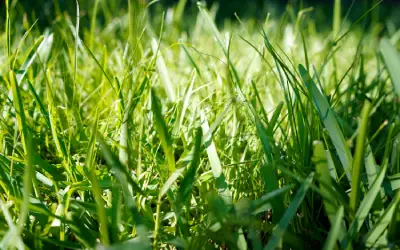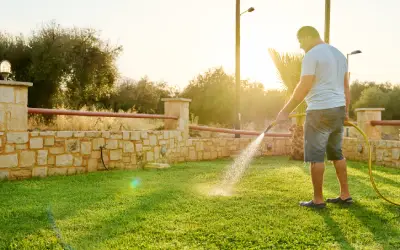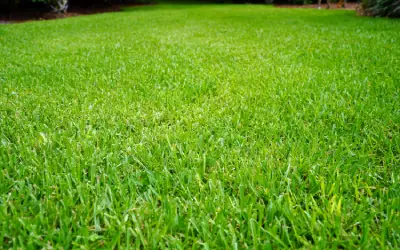
Watering your grass sounds simple, but it can be deceptively complex. There’s more to it than simply turning on your hose or sprinkler system – there’s a right way and a wrong way, and unfortunately, most people are taught how to water their lawn the wrong way. It’s also more challenging to water grass here in Florida than it is in most places, owing to our tropical climate. People often move here and realize they have no idea how to take care of a lawn in Florida.
We’re here to clear all that up. At Sorko Services, we’re experts in Florida lawn care and landscaping, so we wanted to take a few minutes and share some tips we’ve learned along the way.
Use this page as your comprehensive guide to watering your lawn in Florida.
What’s the Correct Way to Water Your Lawn?
Many people mistakenly believe that as long as you’re watering your lawn, that’s enough. The truth is it’s not. You need to give your lawn the right amount of water. If you don’t, you could be weakening your lawn or inviting lawn diseases and fungi into your grass.
The correct way to water your lawn is to identify which species of grass you have, create a custom watering schedule based on its needs, and stick to it as closely as possible. This can be challenging in our region, where a late-afternoon storm can pop up with little warning, forcing you to adjust your watering schedule on the fly to compensate.
Most importantly, avoid this most common mistake that people in Florida (and, honestly, everywhere) make when watering their lawn.
The Most Common Mistake People Make When Watering Their Lawns
Here it is, the most common mistake people make when watering their lawn: watering frequently and lightly. This keeps the topsoil slightly wet most of the time.
Instead of watering this way, you should water less frequently and heavily.
- The wrong way to water your lawn: A little bit of water every day or every other day, just to make sure the grass “doesn’t go thirsty.”
- The right way to water your lawn: A lot of water, less often. “Less often” in this case means two to three times per week.
Why Water This Way? There Are a Few Reasons
- Deeper, less frequent watering encourages roots to grow deeper to search for moisture, which in turn leads to stronger and more resilient grass.
- Allowing the topsoil to dry makes it much more difficult for fungus to multiply.
- Healthier grass is more resistant to diseases.
Get a custom treatment plan tailored to you!
Click below to leave your information and we will call you right back!
Get your home, lawn, and lake in pristine condition. Leave your information and we'll be in touch.
*During normal business hours. After hours calls will be returned the next business day.
How Much Water Should Your Lawn Get?

In general, one inch of water is a good estimate. If you’re not sure how much this is, one easy way to tell is to place an empty can of tuna fish on your lawn while you’re watering. The can is about one inch deep, so once it’s filled, you know it’s one inch of watering.
What’s the Best Time of Day to Water Grass?
“Does it really matter what time I water my grass?” you might be asking yourself. Actually, yes – it does matter. Just like it’s important to water your lawn with the right amount of water, it’s also important to do so at the right time.
We recommend watering your lawn in the morning – anytime between 5 AM and 10 AM is ideal. When you water later than that, the soil is unable to absorb all of it. The temperature gets hot, and much of the water evaporates.
And when you water at night, it leaves your lawn soggy and wet, susceptible to lawn diseases, pests, and fungi.
Tips for Watering Your Grass by Season
How to Water in the Spring
- Florida springs are often hot and dry
- This is the most critical time for lawn irrigation
- Watering should be infrequent and heavy, as outlined above
How to Water in the Summer
- Summer is our rainy season, so take precipitation into consideration before watering
- Turn off your automatic sprinklers and only water when it’s needed
- If we’re getting regular afternoon thunderstorms, you likely won’t need to water at all
- Using an automatic sprinkler system during this time of year often leads to lawn disease
How to Water in the Fall and Winter
- Grass growth slows dramatically during this time of year
- During this time, dormant warm-season lawns are often overseeded with temporary cool-season grasses, like ryegrass, to maintain a green color through the winter
- Watering once a week (or even less) may be enough, depending on temperature and precipitation
Know Your Florida Grasses
Different types of grasses have different needs. For the sake of simplicity, we’re going to divide this into two categories: warm-weather grasses and cool-weather grasses. Warm-season grasses are more common here, but it’s still important to know the difference.
Warm-Season Grasses
They are well-adapted to the state’s hot, humid summers. Their peak growing season is during the late spring and summer months. A key advantage of these grasses is their deep root systems, which make them significantly more drought-tolerant than their cool-season counterparts.

During periods of drought, they may go dormant and turn brown, but they typically recover well once regular watering resumes. In general, warm-season grasses require less frequent but deep watering to encourage a robust root system.
- St. Augustinegrass: Perhaps the most popular residential turfgrass in Florida, known for its broad, coarse leaves and dense, lush appearance. It has a good tolerance for shade and salt. Water Needs: High. Prone to stress and chinch bugs when underwatered.
- Bermudagrass: A durable and fast-growing grass with a fine texture. It is highly drought-tolerant and stands up well to heavy foot traffic, making it a favorite for golf courses and athletic fields. Water Needs: Moderate. Drought-tolerant but requires consistent water for best appearance and active growth.
- Bahiagrass: A very low-maintenance and drought-resistant grass, often seen on roadsides and in pastures. It has a more open growth habit and a coarser texture than many other lawn grasses. Water Needs: Low. Extremely drought-tolerant. A great indicator is that it will wilt visibly when thirsty but recovers quickly after watering or rain.
- Zoysiagrass: Prized for its dense, carpet-like feel, Zoysiagrass is another drought-tolerant option that also exhibits good shade tolerance. It is known for being relatively low-maintenance once established. Water Needs: Moderate to Low. Very drought-tolerant once established, but looks best with consistent moisture.
- Centipedegrass: Often called the “lazy man’s grass” for its slow growth and low fertility requirements. It is well-suited for the sandy, acidic soils found in many parts of Florida. Water Needs: Low. Hates being overwatered, which can lead to root rot.
Cool-Season Grasses
Cool-weather grasses are less common for lawns in most of Florida due to the intense summer heat. Their prime growing seasons are in the spring and fall when temperatures are milder. In the heat of a Florida summer, cool-season grasses struggle and require more frequent watering to survive and avoid going dormant.
How Do You Know When Your Lawn Needs Water?

These tips are intended as a guideline to help you establish your lawn watering best practices. While sticking to a schedule is important, these visual cues help you decide if you need to water on your designated day. If a scheduled watering day is approaching and the lawn shows these signs of thirst, you know it’s time to irrigate. If it looks fine, you may even be able to skip a cycle.
Here are the signs of a thirsty lawn to look for:
- Color Change: Many grasses start to lose that lush green color when they need water. They may start to look blue or even gray.
- Folded Blades: When grass is trying to conserve water, it will often fold itself in half lengthwise.
- The Footprint Test: Walk across your lawn in a pair of heavy shoes. If the grass hasn’t sprung back up and you can still see your footprint after a minute or so, it’s a sign the grass doesn’t have enough moisture.
Know Your Local Florida Watering Restrictions
Many municipalities in Florida have laws and restrictions on when you can and can’t water your lawn. Make sure you’re well aware of these, and tailor your watering schedule to fit within the rules.
Here are some common rules in various parts of Florida. To learn about the specific laws in your area, check your city or county government website.
- Watering only on specific days (e.g., Wednesday/Saturday for odd-numbered addresses).
- A ban on daytime watering, typically between 10 AM and 4 PM, to prevent evaporation.
We’re Here for All of Your Lawn Care Needs
Watering is the foundation, but a truly great lawn requires more. For years, Sorko Services has provided trusted lawn care and irrigation services throughout the Central Florida area, delivering lush landscapes that can stand up to the Florida climate.
Our lawn care includes customized fertilization and maintenance for complete, worry-free care. Stop spending your weekends guessing what your lawn needs. Invest in your home and get a lawn you’re proud of.
Call the local pros at Sorko Services today for a no-obligation lawn care estimate!
Back to Lawn Care Service